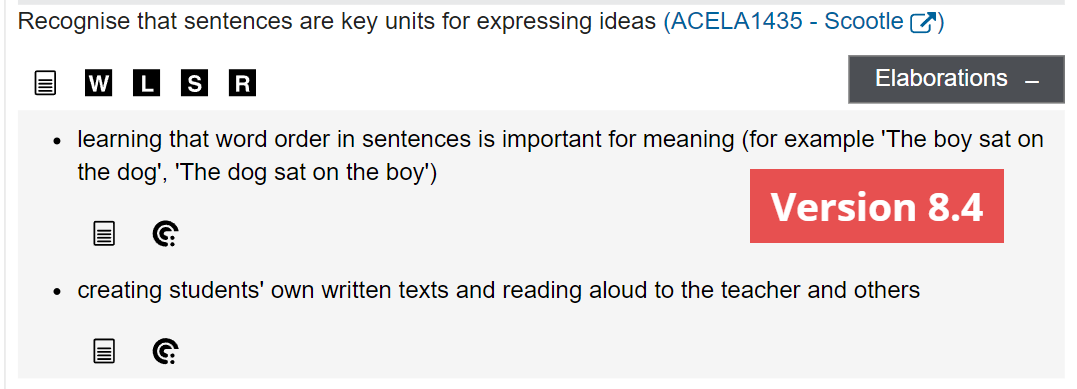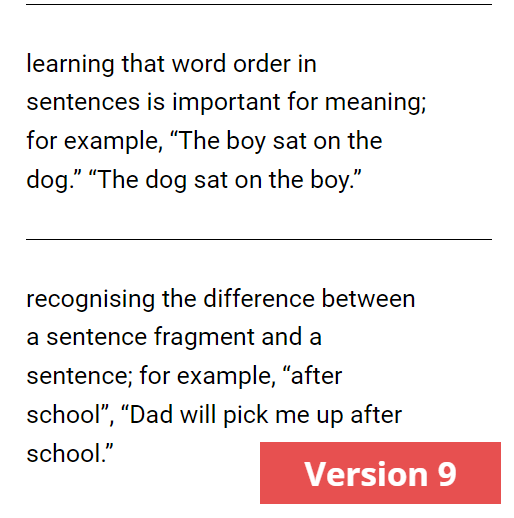Version 9 of the English Curriculum Has Landed

The new Australian Curriculum is out and there is some exciting news. The words ‘predictable texts’ and ‘combining contextual, semantic, grammatical and phonic knowledge’ are now gone. Other worrisome phrases such as ‘visual memory’ have disappeared from the year 1 descriptors that relate to reading and writing high-frequency words. These changes reflect the growing understanding of how we learn to read and are to be celebrated. No longer will we have to try and counter arguments in favour of levelled readers or three cueing strategies that are based in the fact that they are mentioned in the Australian Curriculum. There will still be arguments made, but the curriculum will no longer be a part of that.
Over the past couple of days I have compared the V8.4 and V9 of the curriculum, content descriptor by content descriptor and want to share my impressions with you and what I think the changes to the English curriculum will mean for teachers.
Firstly, when people say that it is a ‘pared back’ curriculum, as far as English goes, they aren’t talking about content. There are slightly fewer content descriptors in Version 9, but not much has actually been removed. Several content descriptors have been combined. When you look at what has been combined, you will see that it made sense to do so. In terms of content, it’s much the same as Version 8.4. The good news in that is that primary teachers don’t have to reframe the entire teaching and learning focus of their English teaching. There are different codes attached to the descriptors, but you can rest easy that your past planning in years gone past will not be wasted.
What has changed, I am pleased to say, is that many things are a bit more direct. One of the biggest implications for us is that it will be easier for us to understand what the curriculum is asking from us. This has been achieved in a few ways.
Firstly, the descriptors/descriptions themselves are mostly more specific. The word ‘understand’ appears far less often. Instead, there is a greater focus on what students will do. Words such as ‘explore, identify, recognise, share, respond, interact and retell’ make things much clearer.
Here is an example from Year 1.
Version 8.4 - Discuss features of plot, character and setting in different types of literature and explore some features of characters in different texts ACELT1584
Version 9 – Discuss plot, character and setting, which are features of stories AC9E1LE03
Secondly, the many elaborations have been adjusted. Many elaborations haven’t changed at all, but those that have often reflect changes in current classroom practice as in the examples below. The elaborations aren't necessarily simpler, just a bit different.


Thirdly, achievement standards appear to better reflect current classroom practices than the old versions did and are more specific.
When reading, they use knowledge of the relationship between sounds and letters, high-frequency words, sentence boundary punctuation and directionality to make meaning.
Has been replaced with
They blend short vowels, common long vowels, consonants and digraphs to read one-syllable words. They read one- and two-syllable words with common letter patterns, and an increasing number of high-frequency words. They use sentence boundary punctuation to read with developing phrasing and fluency.
The structure of the achievement standards has also changed. The structure of Version 8.4 of receptive and productive modes have been replaced by three distinct paragraphs, that while not labelled as such, clearly relate to oral language, reading and writing.
|
Version 8.4 Achievement Standard . Receptive Modes By the end of Year 1, students understand the different purposes of texts. They make connections to personal experience when explaining characters and main events in short texts. They identify that texts serve different purposes and that this affects how they are organised. They describe characters, settings and events in different types of literature. Students read aloud, with developing fluency. They read short texts with some unfamiliar vocabulary, simple and compound sentences and supportive images. When reading, they use knowledge of the relationship between sounds and letters, high-frequency words, sentence boundary punctuation and directionality to make meaning. They recall key ideas and recognise literal and implied meaning in texts. They listen to others when taking part in conversations, using appropriate language features and interaction skills. Productive Modes Students understand how characters in texts are developed and give reasons for personal preferences. They create texts that show understanding of the connection between writing, speech and images. They create short texts for a small range of purposes. They interact in pair, group and class discussions, taking turns when responding. They make short presentations on familiar topics. When writing, students provide details about ideas or events, and details about the participants in those events. They accurately spell high-frequency words and words with regular spelling patterns. They use capital letters and full stops and form all upper- and lower-case letters correctly. |
Version 9 Achievement Standard
By the end of Year 1, students interact with others, and listen to and create short spoken texts including recounts of stories. They share ideas and retell or adapt familiar stories, recount or report on events or experiences, and express opinions using a small number of details from learnt topics, topics of interest or texts. They sequence ideas and use language features including topic-specific vocabulary and features of voice. They read, view and comprehend texts, monitoring meaning and making connections between the depiction of characters, settings and events, and to personal experiences. They identify the text structures of familiar narrative and informative texts, and their language features and visual features. They blend short vowels, common long vowels, consonants and digraphs to read one-syllable words. They read one- and two-syllable words with common letter patterns, and an increasing number of high-frequency words. They use sentence boundary punctuation to read with developing phrasing and fluency. They create short written and/or multimodal texts including recounts of stories with events and characters. They report information and experiences, and express opinions. Ideas in their texts may be informative or imaginative and include a small number of details from learnt topics, topics of interest or texts. They write simple sentences with sentence boundary punctuation and capital letters for proper nouns. They use topic-specific vocabulary. They write words using unjoined upper-case and lower-case letters. They spell most one- and two-syllable words with common letter patterns and common grammatical morphemes, and an increasing number of high-frequency words. |
One other change to note is that the content descriptors that deal with students learning word level knowledge and reading has moved from the 'Language' section to the 'Literacy' section. This change is more in-line with the way that many of us run our literacy blocks.
In reviewing the English curriculum from Foundation to Year 6, these changes are consistent. Overall, Version 9 presents us with a more slightly direct outline of what it is we need to teach in English. If you were hoping for less content, more explanation of the specifics of content (phonics knowledge, morphology knowledge, reading rate etc) or an indication of how English is to be taught, you won’t find it here. Each state and territory, and indeed each school, will still need to work that out for themselves.
To help you put these new achievement standards to work, I have created a series of 'I can' statements based on the standards for Foundation to Year 2. You can download them, and the grading guidelines below.


 Jocelyn Seamer Education
Jocelyn Seamer Education
5 comments
Very helpful - Thank you!
This is a brilliant guide/explanation to a somewhat complex curriculum. Thank you for the extra effort you put in. It is very much appreciated.
Super helpful, are you planning on creating I can statements for years 3-6?
Will you be doing the same for years 3-6?
Will you be doing this for Years 3-6 by any chance?
Leave a comment